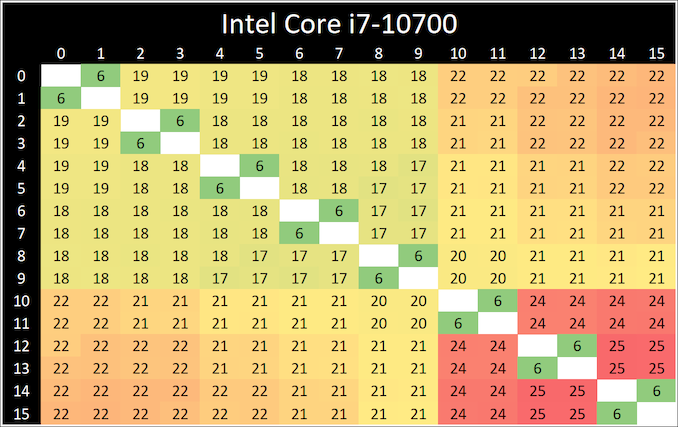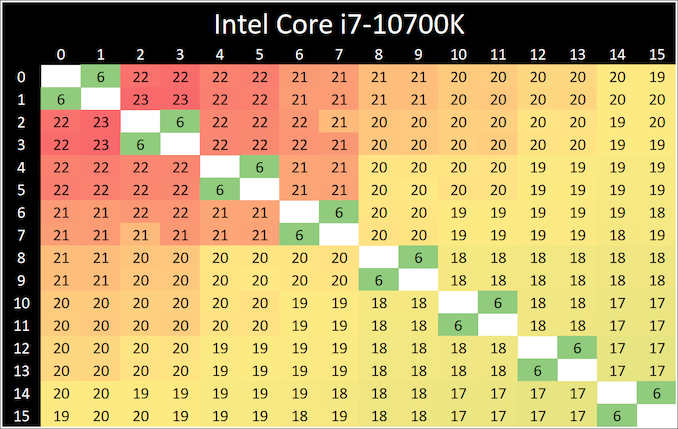Intel Core i7-10700 vs Core i7-10700K Review: Is 65W Comet Lake an Option?
by Dr. Ian Cutress on January 21, 2021 10:30 AM EST- Posted in
- CPUs
- Intel
- Core i7
- Z490
- 10th Gen Core
- Comet Lake
- i7-10700K
- i7-10700
CPU Tests: Microbenchmarks
Core-to-Core Latency
As the core count of modern CPUs is growing, we are reaching a time when the time to access each core from a different core is no longer a constant. Even before the advent of heterogeneous SoC designs, processors built on large rings or meshes can have different latencies to access the nearest core compared to the furthest core. This rings true especially in multi-socket server environments.
But modern CPUs, even desktop and consumer CPUs, can have variable access latency to get to another core. For example, in the first generation Threadripper CPUs, we had four chips on the package, each with 8 threads, and each with a different core-to-core latency depending on if it was on-die or off-die. This gets more complex with products like Lakefield, which has two different communication buses depending on which core is talking to which.
If you are a regular reader of AnandTech’s CPU reviews, you will recognize our Core-to-Core latency test. It’s a great way to show exactly how groups of cores are laid out on the silicon. This is a custom in-house test built by Andrei, and we know there are competing tests out there, but we feel ours is the most accurate to how quick an access between two cores can happen.
When we first reviewed the 10-core Comet Lake processors, we noticed that a core (or two) seemed to take slightly longer to ping/pong than the others. These two parts are both derived from the 10-core silicon but with two cores disabled, and we still see a pattern of some cores having additional latency. The ring on the 8-core parts still acts like a 10-core ring, but it all depends on which cores were disabled.
Frequency Ramping
Both AMD and Intel over the past few years have introduced features to their processors that speed up the time from when a CPU moves from idle into a high powered state. The effect of this means that users can get peak performance quicker, but the biggest knock-on effect for this is with battery life in mobile devices, especially if a system can turbo up quick and turbo down quick, ensuring that it stays in the lowest and most efficient power state for as long as possible.
Intel’s technology is called SpeedShift, although SpeedShift was not enabled until Skylake.
One of the issues though with this technology is that sometimes the adjustments in frequency can be so fast, software cannot detect them. If the frequency is changing on the order of microseconds, but your software is only probing frequency in milliseconds (or seconds), then quick changes will be missed. Not only that, as an observer probing the frequency, you could be affecting the actual turbo performance. When the CPU is changing frequency, it essentially has to pause all compute while it aligns the frequency rate of the whole core.
We wrote an extensive review analysis piece on this, called ‘Reaching for Turbo: Aligning Perception with AMD’s Frequency Metrics’, due to an issue where users were not observing the peak turbo speeds for AMD’s processors.
We got around the issue by making the frequency probing the workload causing the turbo. The software is able to detect frequency adjustments on a microsecond scale, so we can see how well a system can get to those boost frequencies. Our Frequency Ramp tool has already been in use in a number of reviews.
Both processors ramp from idle to full turbo in about six milliseconds, well within a single frame of standard gaming.













210 Comments
View All Comments
Mr Perfect - Thursday, January 21, 2021 - link
Yeah, if Alder Lake doesn't get things under control later this year, my next ITX build will also be Ryzen. There's just no sense in using a CPU drawing 200+ watts in SFF when cooling the current crop of GPUs is hard enough as it is!DanNeely - Thursday, January 21, 2021 - link
In SFF I suspect you'll be operating well below 215W. If not because the mobo can't supply the power, but because your small form factor cooler can't handle the heat and you're limited to short turbo periods due to thermal throttling.Mr Perfect - Thursday, January 21, 2021 - link
You should well be able to run the 215watt mode if you're daring. Some folks over on r\sffpc use the big CPUs, because the mITX boards have power delivery similar to the ATX boards and do support them. The problem is they report idle temps around 50C and gaming temps around 70C.Personally, I'm just not willing to run those temps. My current ITX build is using an older 95watt CPU(that actually drew 95watts at turbo) and idles at 35C and games around 50C. A new CPU with an idle temp that's the same as my current load temp is just mind boggling.
Dug - Thursday, January 21, 2021 - link
You do realize that 50 and 70c are not anywhere close to being worried about anything? You said personally you aren't willing to run those temps. Have you even looked into what modern processors are capable of? Have you ever used a laptop, which will hit that temp just by opening the lid?Calin - Friday, January 22, 2021 - link
I remember one processor (or maybe GPU) had temperature limits (internal temperature, as measured on-die) of a bit over 100 Celsius. It might have been an NVidia chip, however I remember Intel coming close to that.Compared to that, 50 Celsius at idle and 70 at load is positively arctic ;)
at_clucks - Friday, January 22, 2021 - link
Perhaps idling at 50 is not outstanding but full load at 70 definitely is, especially for a cramped SFF PC.Spunjji - Friday, January 22, 2021 - link
It all depends on the fan speeds, really. 50 at idle is extremely impressive if the system is silent!Wineohe - Thursday, January 21, 2021 - link
I too just picked up a 5600X for list of $299 to build a NAS. Paired it with a $120 B550, some extra RAM and a video card I had collecting dust. Wish I would have researched the case more though. Ironically it’s considerably faster than my desktop with it’s pokey old i7-6800K. I’ll wait until the 5950X comes more readily available for a upgrade.schujj07 - Friday, January 22, 2021 - link
Using a 5600X for a NAS, I assume it is for home and not enterprise, is total overkill. You would be fine using an Athlon 200G in a home NAS and would never notice the difference.magreen - Friday, January 22, 2021 - link
I run a pentium M for my Ubuntu server/NAS